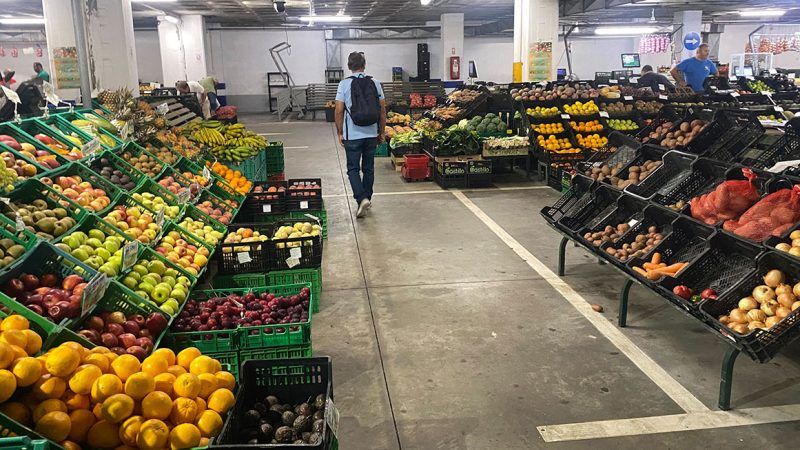Giving Parking Garages New Life
Blame local government parking minimums for the overabundance of parking in the U.S.

I recently found myself descending what looked like subway stairs into a dark underground parking garage. All alone, on the Portuguese island of São Miguel, in the city of Ponta Delgada—if you can even call it a city—I stumbled upon a veritable wonderland of baby pineapples, passion fruit, and magnificent clusters of tiny bananas. Wheels of soft sheep's milk cheese adorned one stall. The salty stench of dried fish wafted from some distant corridor.
The Azores are smack dab in the middle of the Atlantic. Technically a chain of Portuguese islands (so far apart from each other that one must island-hop via planes, not boats), they're verdant, yet sparsely populated. São Miguel, the largest, is home to thermal springs, a few active volcanoes, and consistently decent surf—the reason I was visiting.
Stumbling upon this bounty of produce at Mercado da Graça came as no surprise. What was a surprise was that this splendid farmers market was housed in a decommissioned parking garage.
Word below the street was that the market had shifted underground in October 2021 because the open-air stalls were getting much-needed renovations. But in typical Portuguese style, as of September 2023 construction was still active. The temporary location could well be considered permanent.
It's not the first parking garage I've seen repurposed for good.
Take Austin, Texas, where I used to live. If you ever find yourself on Colorado Street, between West 5th and 6th, late at night, it may just look like you're surrounded by parking garages and office buildings. But if you venture a little deeper into the caverns of concrete, you may find yourself spit out into a vinyl lounge/cocktail bar with a bit of a waitlist. Order yourself a yerba buena—pisco, Japanese yuzu vermouth, lemon, pineapple-tahini soda, and togarashi—or something off the "unleaded" menu, perhaps, and take in the music.
Or take Wichita, Kansas. Back in the 1950s, Broadway Autopark was a bona fide parking garage. Now it's been converted into luxury apartments (with all the midcentury modern trappings that both tie it back to that old era and give it high design status today). Or Los Angeles, where some parking garages have been turned into delivery-only ghost kitchens, and where at least one restaurant—Dollar Hits—takes the idea of street food literally, letting you cook skewers of chicken feet and meatballs on little grills in the parking lot. Or La Chapelle, a neighborhood in Paris, where a subterranean hydroponic mushroom farm has popped up in an abandoned underground parking structure.
At least in the U.S., parking minimums are to blame for the overabundance of lots and garages. First mandated in the 1950s, with the intention of alleviating some of the demand for street parking, they forced developers in most municipalities to build preordained numbers of off-street parking spaces. L.A. requires one parking space per five seats in a pew, and two spaces per hospital bed. Even in dense New York City, where I live, and where only 45 percent of households own a car, such things are frequently mandated: "On average, for every 100 new housing units built in the city, 43 off-street spaces are created," reported Bloomberg's Eric Jaffe in 2012, using data from the New York University Furman Center.
"While developers have both the incentive and local knowledge to determine how much parking a project requires—too few spaces and the units won't sell; too many spaces and the developers waste money—minimum parking requirements supersede their judgment with often-arbitrary standards," urbanist M. Nolan Gray recently wrote in The Atlantic. "Minimum parking requirements effectively demand that each resident consumes more land," which in turn makes each new housing or commercial project more expensive than it needs to be.
"Of about 300 housing developments built in the last decade or so, 77 percent created the exact minimum number of parking spaces, or very near it," noted Jaffe. If there were demand for it, developers would seemingly set aside even more spaces, exceeding the minimum; the fact that they don't, generally speaking, is strong evidence for the idea that central planners are mandating they provide more spaces than are actually needed.
Regardless of whether these parking garage sizes were forced, as in many parts of the U.S., or built voluntarily by developers who found them necessary at one time, it's wonderful seeing all the ways they can be transformed as needs change. At some point—if southern Europe ever grows a Protestant work ethic—Mercado da Graça's renovations will be finished, and the vendors will move into the light. But until then, a repurposed parking garage is a wonderful example of how people co-opt urban spaces, no matter how sterile and harsh, as their needs change, breathing new life into them.



Show Comments (92)